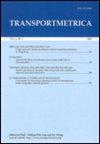Passenger car units and saturation flow models for highly heterogeneous traffic at urban signalised intersections
引用次数: 55
Abstract
Signalisation is a traffic control strategy to ease the competition by providing right-of-way in a cyclic manner to conflicting traffic at intersections. Saturation flow is a major component in the design of signals, and is influenced by a variety of factors like vehicle composition, intersection geometry and driver's behaviour. The highway capacity manual (HCM) has recommended a saturation flow model primarily for homogeneous conditions, with limited ability to address heterogeneity. But the traffic in many parts of the world is highly heterogeneous and hence, defining a unified saturation flow concept is a challenging task. The variability in vehicle types necessitates the use of passenger car units (PCUs). This article proposes a methodology to develop a saturation flow model based on dynamic PCUs by a microscopic analysis. Field data from intersections of three Indian cities – Jaipur, Bangalore and Trivandrum – is used for the study. PCU values are derived from the field data, by minimising the difference between the observed and the ideal flow profiles. A new saturation flow model is then developed using the regression method. The model is validated with the saturation flows collected from different locations. In addition, the flow predicted by the saturation flow model is used to estimate delay using the HCM and Webster's models, and these delays are compared to the observed delays. The proposed model resulted in lower error compared to the conventional flow estimation techniques.城市信号交叉口高度异构交通的乘用车单元和饱和流模型
信号是一种交通控制策略,通过循环方式为交叉路口的冲突车辆提供路权,以缓解竞争。饱和流是信号设计的一个重要组成部分,它受到多种因素的影响,如车辆组成、交叉口几何形状和驾驶员行为。高速公路通行能力手册(HCM)推荐了一种饱和流模型,主要用于同质条件,解决异质性的能力有限。但是世界上许多地区的流量是高度异构的,因此,定义一个统一的饱和流量概念是一项具有挑战性的任务。车辆类型的变化需要使用乘用车单元(pcu)。本文提出了一种通过微观分析建立基于动态pcu的饱和流动模型的方法。这项研究使用了印度三个城市——斋浦尔、班加罗尔和特里凡得琅的交叉路口的实地数据。PCU值是根据现场数据得出的,通过最小化观察到的与理想流动曲线之间的差异。然后利用回归方法建立了一个新的饱和流模型。用不同地点采集的饱和流对模型进行了验证。此外,利用饱和流模型预测的流量来估计HCM和Webster模型的延迟,并将这些延迟与观测到的延迟进行比较。与传统的流量估计技术相比,该模型的误差较小。
本文章由计算机程序翻译,如有差异,请以英文原文为准。
求助全文
约1分钟内获得全文
求助全文

 求助内容:
求助内容: 应助结果提醒方式:
应助结果提醒方式:


